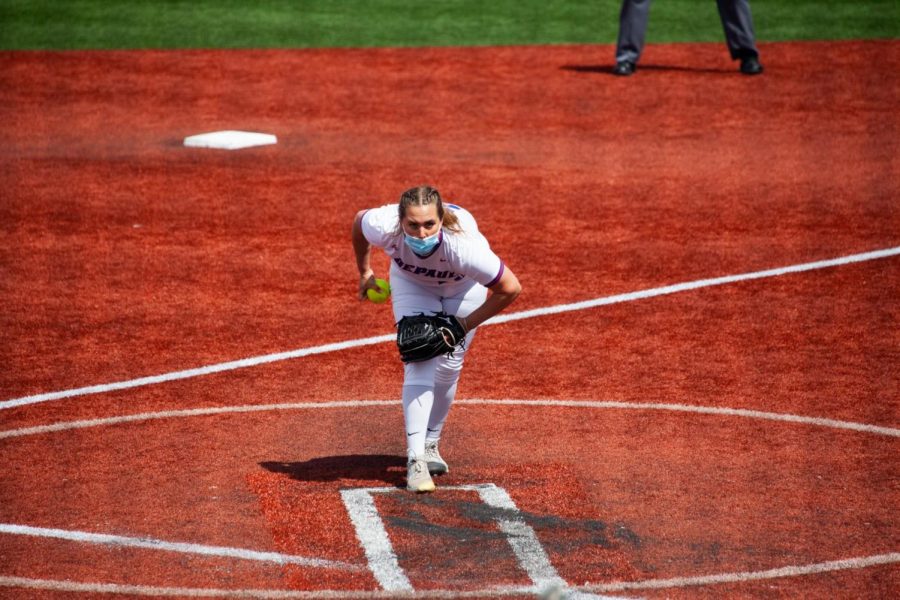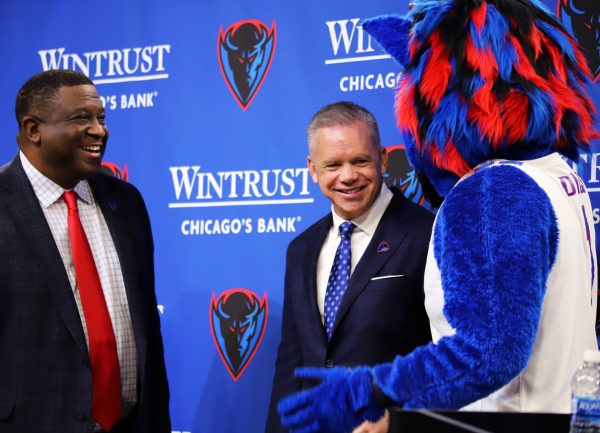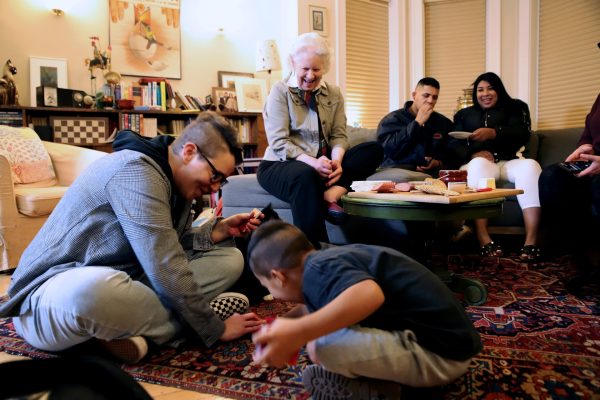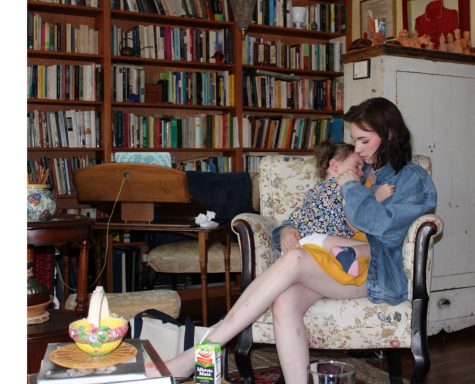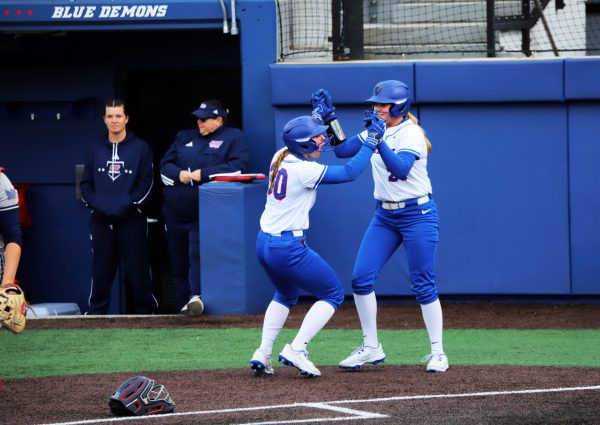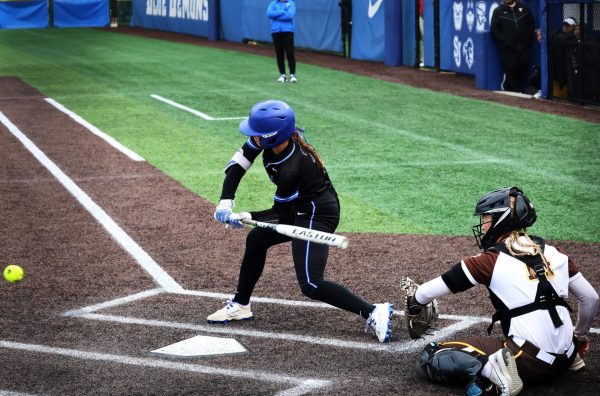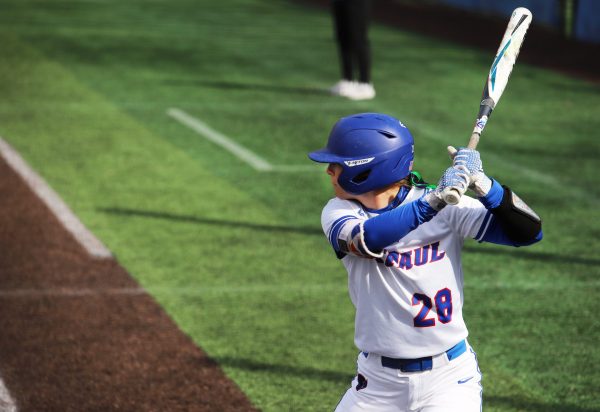DePaul seniors lead softball team from the circle
DePaul senior pitcher Krista Dalgarn winds up for a pitch during a game this season. In 13 appearances, Dalgran is 11-2 and has two saves with a 3.02 ERA.
At any given time this season, DePaul’s softball team is most likely split perfectly in half — two complete teams who could each feasibly take the field should Covid-19 strike the other and disqualify half the roster. They ride in separate buses, practice and lift weights separately and sit apart on airplanes. Because of that, starting pitchers Natalie Halvorson and Krista Dalgarn, both seniors, are most often kept apart outside of game days.
As the two most reliable and experienced pitchers on the team, Halvorson and Dalgarn are leading almost every inning defensively. In a season consisting mostly of weekend tournaments including three-game series and double-headers, the pitcher’s job only becomes more important and more challenging as the weekend wears on.
Most weekends end with the two veteran pitchers splitting most of the games, one starting and the other relieving and then turning around and doing it again for the next game. During the series against Creighton on April 17 and 18, Dalgarn threw a total of 162 pitches over the course of three games, including a shut-out in the first outing. Naturally, fatigue manifests further with each new pitch.
“I get a little bit tired, but you just kind have got to push through it,” Dalgarn said. “They always say, ‘You have to be comfortable with being uncomfortable.’ And I’ve really learned to just be like, you know what, I’m sore and that’s okay. But as long as I’m able to go out there and keep form and just spin it, then I can hopefully help us win a game because that’s what I’m out there to do. I just go out there and say ‘Just win the game, it doesn’t have to be pretty.’”
Ideally a team’s roster will have three or four pitchers in active rotation, but at the end of the day, experience and dependability often win out. With a developing group of pitchers behind them, including freshman Julyana Gomez who has shown serious potential the few times she’s stepped on the field at the collegiate level, Halvorson and Dalgarn are tried and true defensive tools to earn wins for the Blue Demons.
“If we had more ability to put more out there, it would be great because then everyone’s going to be fresher when we get to the conference tournament and they’ll be fresher when you get hopefully to the NCAA tournament,” said head coach Tracie Adix-Zins. “But it worked out how it did. And I mean, I’m not going to complain about it, Natalie and Krista know what they need to do and I know they’re willing to do whatever they need to do to win us games.”
The high pitch count can obviously weigh on a pitcher throughout the tournaments, especially as the season goes on. While Halvorson and Dalgarn play invaluable roles each game, Adix-Zins said that she’s realistic about what to expect in the later innings of a long weekend.
“And I think I’ve talked to them enough about, look, game three, give me what you got,” Adix-Zins said. “Whoever is the starter, give me three or four innings. If you can do that, then we’ll bring the next person in and they’ll finish out the game.”
While one might think this role on the team comes with added pressure, Halvorson said she and Dalgarn are used to it — both because they’re comfortable with the inherent pressure that comes with pitching and because they’ve done it together before. Just a couple of seasons ago they were in this same situation, Halvorson said.
“Knowing that we’ve already done this, like I have faith that we are more than capable of doing it again,” Halvorson said. “We’ve had time to train and get better and I’m confident in that. When it gets to the end of the day or towards the end of the game, you’ve got to just dig deep and make it work. It might not look perfect, but you just have to make it happen and trust that other people will pick you up.”
Any kinks in the roster that would have traditionally been worked out by the start of the regular season, including development of younger players, were complicated this season after the low-stakes fall games were cancelled. Without them, the team wasn’t able to experiment with different lineups and pitchers in games that wouldn’t impact their record. Next year, Adix-Zins hopes to take advantage of that time once again.
“It’s hard when you’re a pitcher and your first game in college is a game that counts,” Adix-Zins said. “No matter what, you put that pressure on yourself, that crap, this game is for a win loss that will go towards our record, which will go towards a potential at large bid at the end of the year. Having those fall games just gives a lot of people that time to at least get collegiate innings against somebody other than our pitchers throwing to them during the day.”
For most starting pitchers in the conference, breaks come in the form of midweek games — if any break comes at all. Most teams, Adix-Zins said, will try to throw their third and fourth string pitchers during the midweek games to provide some rest time to the starters who are coming off a weekend series. But, she said, that’s sometimes better in theory than in practice.
“I would love to have more [pitchers] just because it keeps your one and two fresher as you get further,” Adix-Zins said. “If I could give Krista and Natalie that reprieve where somebody else can throw a game or try to throw the midweeks, I would love to. But I’m also trying to strategize, ‘how am I going to win games?’”


